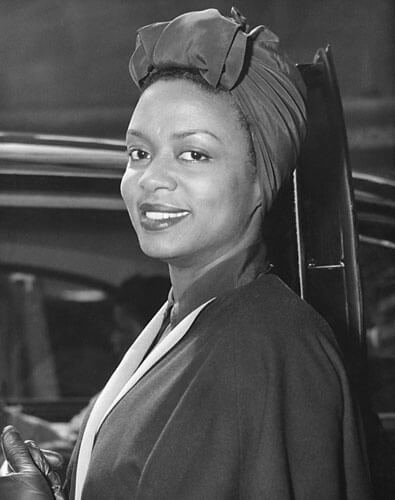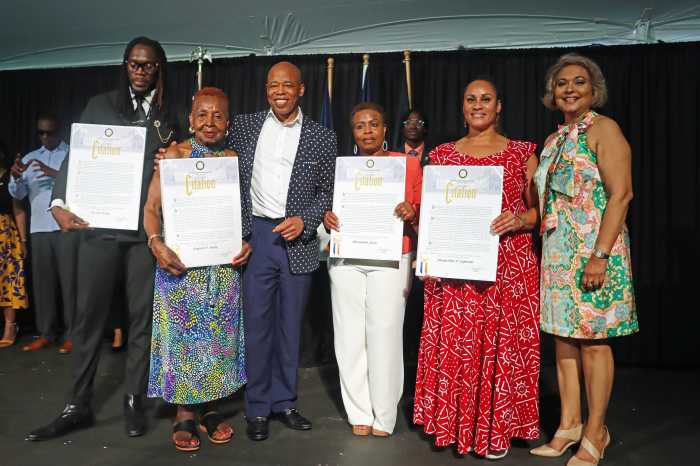A befuddling curiosity it is, how conspicuously absent Hazel Scott’s name and contribution on more than one level have been from the story of African American struggle and survival, in New York City and in the U.S. overall. For an individual who accomplished as much as she did, both as an exceptionally gifted artist and a crusader for equal rights, Scott’s exclusion from, or at best minimalist presence in, the honor roll of outstanding trailblazers of color is a travesty.
Born in Trinidad in 1920, Scott migrated with her family to the U.S. when she was four years old, the family settling in the cultural oasis that was New York’s Harlem. No doubt influenced by her mother, a musician, Scott’s piano playing ability soon established her as a child prodigy, and as early as age 8, she was given scholarships to study at famed Juilliard School. The young musical wiz, who could also deliver vocals with the best of them, was already doing gigs in her teens, including performances on radio. Jazz piano stalwarts such as Art Tatum and Teddy Wilson were said to be among her mentors in that genre. But Scott remained a top-echelon performer of classical music as well, and in time her ingenuity in concocting swinging interpretations of classical compositions would boost her growing popularity.
Scott’s standout talent led to engagements in leading New York nightclubs, like trendy Café Society and the Cotton Club; to appearances with major headliners, including sharing the bill at Roseland with the Count Basie orchestra; and to multiple musical theater productions, including stints at Carnegie Hall. Amazingly, this was all happening when she was but a young, twentyish dynamo. Added to which, the Scott package included vivaciousness. Blessed with an attractiveness that only enhanced her stage appeal, she was a natural for films and, when it became part of the entertainment menu, television. By 1945 she had appeared in films for major studios, including “Something to Shout About,” “Broadway Rhythm,” “I Dood It” and “Rhapsody in Blue.”
Scott was said to have given indications of being independent-minded from rather early, which evidently framed her perspective on the social condition for people of color. What seems clear is that by the time she had become a much-in-demand performing artist, she was determined to stand firm against the systemic inequality that was an everyday reality for people of color.
She refused to perform in segregated venues. She once successfully sued a restaurant in Washington state for denying her service because of her color. When Hollywood beckoned, Scott was adamant about not accepting roles that perpetuated what had become the black stereotype for movies of the era – roles which invariably presented blacks as dispensable sideshow props. She also insisted on having control over how she appeared in films, reserving the right to wear her own clothing if she wasn’t satisfied with a studio’s choice of wardrobe.
This obviously was unusual spunk for a young artist. And having demonstrated how prepared she was to battle the establishment in her professional career, whenever she felt short-changed on account of her race, it was hardly a surprise that she would be driven by the same fighting spirit to rail against injustice to people of color throughout the society. The commitment to such activism could only intensify when, in 1945, she married the political firebrand and powerful pastor of Harlem’s Abyssinian Baptist Church, Adam Clayton Powell, Jr. Even so, the 1940s were a heady time for Scott professionally, as she maintained a busy engagement schedule. Then in June, 1950 she ascended to another plateau when she became host of her own television show on the DuMont network, one of the first African American women given such a role.
But the Hazel Scott saga would dramatically change in the 1950s. She would be caught in a net cast by head-hunting politicians during the “Red Scare” when suspicion of Communist infiltration in America became a cause célèbre. Scott found herself identified as one of many individuals in entertainment labeled a Communist sympathizer, and was ordered before the House Un-American Activities Committee (HUAC) in September, 1950. Merely being a HUAC target was notoriety enough to affect her career. The first shoe dropped right after her HUAC appearance, when her TV show was canceled. Effectively blacklisted, her engagements declined markedly. By the late 1950s those continuing difficulties prompted her move to Paris, where she could perform unimpeded. When she moved back to New York in 1967, her live musical performances and some turns on TV came, as in Europe, with much less buzz than two decades earlier. This relative obscurity would endure until her death in October, 1981.
A brilliant musical talent and courageous equal-opportunity warrior, Scott clearly rankled an establishment for which sidelining folks who dared to not “go along to get along,” was paramount. Her consequently reduced profile doesn’t negate that from Scott came one of the important individual efforts in the black struggle for dignity and respect.


























